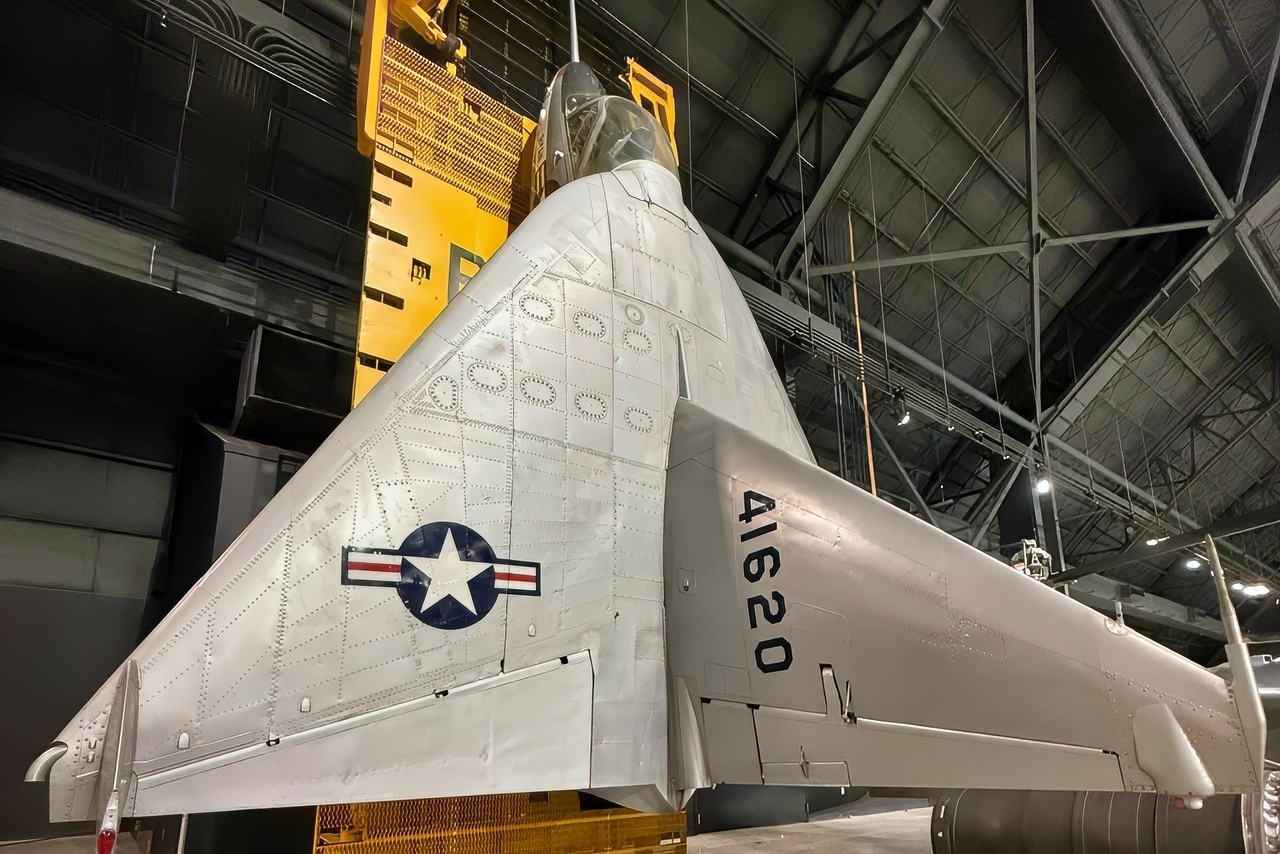Key Points and Summary – The Ryan X-13 Vertijet was the Air Force’s 1950s answer to runway vulnerability: a tail-sitting jet that hovered on thrust, transitioned to level flight, and recovered by hooking a vertical line on a tilting trailer.
-It validated reaction-control thrusters, pilot ergonomics for vertical recovery, and a portable basing concept—and wowed crowds with a Pentagon-area demo.
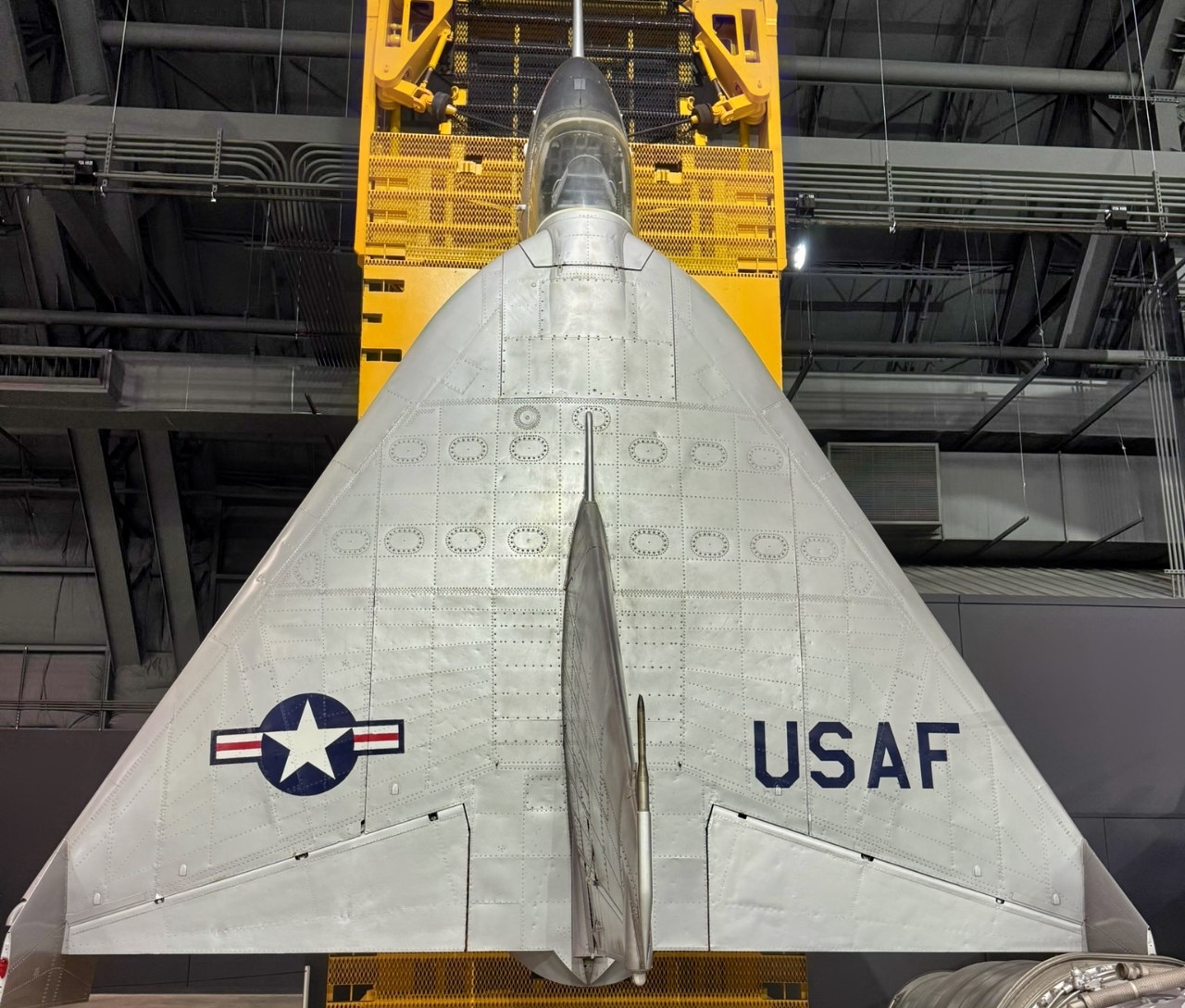
Ryan X-13 Image by National Security Journal. Taken By Harry J. Kazianis.
-It failed as a fieldable fighter for the reasons tail-sitters always do: punishing pilot workload in crosswinds, thin payload/range once you budget fuel for vertical ops, and better VTOL paths (vectored thrust, lift systems) arriving fast.
-The Vertijet’s legacy is the know-how it gave to every VTOL and high-alpha program since.
-All pictures in this article are from the author’s recent trip to the U.S. Air Force Museum in Dayton, Ohio.
Ryan X-13 Vertijet: The Tail-Sitting Moonshot That Taught The U.S. To Hover
Walk up to the Ryan X-13 at the National Museum of the U.S. Air Force and it looks like a sleek torpedo waiting to be hoisted aboard a ship.
That was the point. In the 1950s, planners feared that concrete runways—the lifeblood of jet airpower—would be the first casualties of a nuclear exchange. If the enemy cratered bases or jammed them with unexploded ordnance, fast jets would be useless without someplace to take off and land.
One answer was radical: skip the runway altogether.
The Air Force and Navy both explored vertical takeoff and landing (VTOL) for jets to disperse, survive, and fight from improvised sites—highway cloverleafs, small clearings, even the deck of a modest ship. A jet that launched like a rocket and recovered to a simple mast or pad promised a kind of basing agility no bomber or fighter had.
The Ryan X-13 Vertijet was the Air Force’s cleanest test of that idea: a pure jet tail-sitter that would prove you could hover a combat-weight airplane on thrust alone, transition to forward flight, and then come home to hook onto a vertical line instead of flare onto a runway.
The Odd Configuration: A Jet That Landed On Its Nose
The X-13 flipped every instinct pilots have. Instead of a tricycle landing gear, it had no conventional gear at all—just a small takeoff/landing skid and a retractable nose hook. In “recovery mode” the airplane stood nearly straight up, nose pointing skyward, facing a vertical arresting line strung on a tall A-frame mounted to a tilting trailer.
The pilot aimed the hook at the line, caught it, and then the trailer eased the aircraft down to a horizontal posture. For launch, the trailer raised the airframe to vertical; the jet lit, came off the line, stabilized in a hover, rotated to level, and flew away.
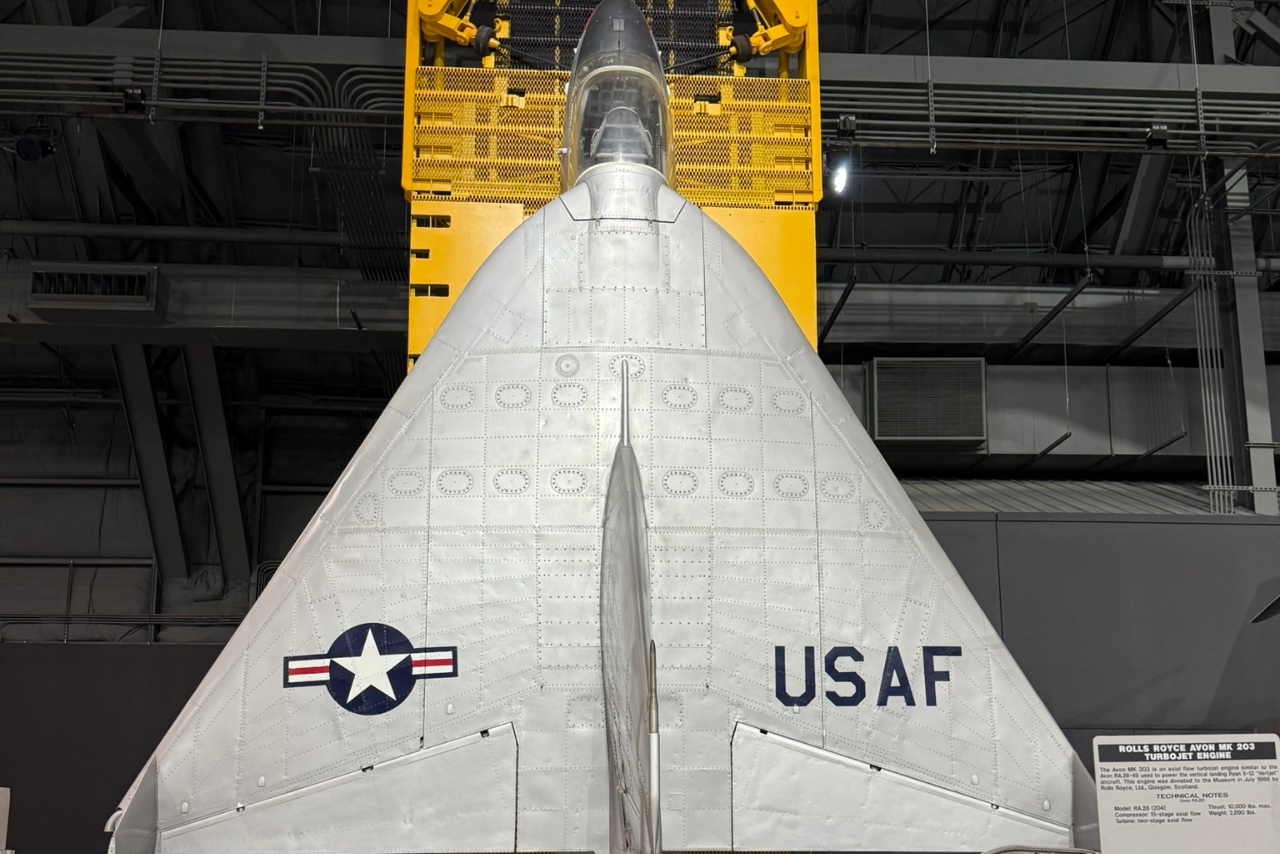
X-13 From the USAF Museum. Image By Harry J. Kazianis, National Security Journal.
To make that circus act possible, Ryan gave the X-13 a tiny delta wing with large elevons for normal flight and reaction controls—small jet “puffers” driven by bleed air—at the nose and wingtips for hover and very low speed.
Those puffers handled pitch, roll, and yaw when regular control surfaces were useless in the slow, vertical regime. A tilting pilot’s seat and a carefully framed canopy helped the pilot look “down” the nose toward the arresting line during recovery. Power came from a single license-built British turbojet (the J65), chosen for reliability and a decent thrust-to-weight ratio in a compact package. Everything about the airframe was optimized for a singular job: hang on thrust, pivot gracefully, and never touch a runway.
How The Vertijet Actually Flew
Like any VTOL design that lives near the edges of control, the X-13 learned to walk on a leash. Ryan engineers first tethered the aircraft for captive hovers, mapping how the reaction controls, throttle response, and inlet airflow behaved. Once crews trusted the control laws and the engine’s spool-up characteristics, the team cut the tether for full free hovers, then added the transition to and from level flight.
In forward flight the X-13 behaved like a crisp little delta—quick in pitch and roll, happiest fast and clean. The hard parts came right where the concept promised the most: recovery. The pilot would approach vertically, throttle modulating the climb or sink as the reaction controls nudged the nose and wings. In a steady hover, the airframe is basically a pendulum with a fire-hose for a heart; any throttle overshoot or crosswind gust can start a gentle swing that grows until the pilot damps it out. The pilot then drove the hook onto the cable, caught it, and let the trailer lower the machine to horizontal so crews could secure and service it.
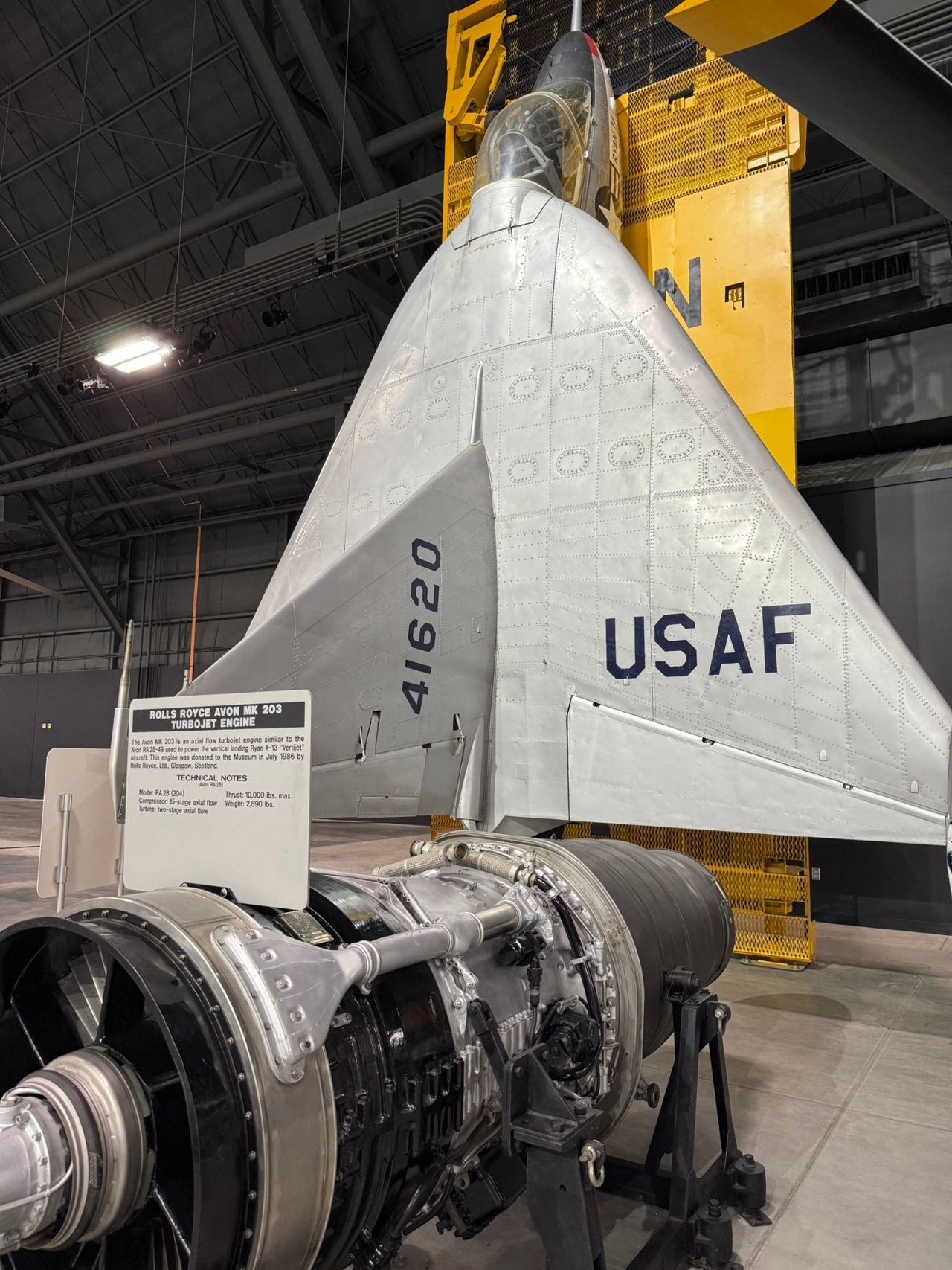
X-13 and Engine. Image By National Security Journal.
It worked. In 1957, the X-13 performed public transitions and a headline-grabbing demonstration near the Pentagon, rising off its trailer, flying a short profile, returning to the vertical line, and snagging the hook on cue. The spectacle wasn’t a stunt. It was the proof-of-concept that a jet could take off and land vertically without lift fans, rotors, or tilt-wings—and could do it with a pilot who still had the hands for level flight aerobatics.
What The Program Proved—And What It Didn’t
On the success side of the ledger, the Vertijet nailed the control problem. It validated reaction-control thrusters for hover, the pilot ergonomics needed to look “down” a vertical approach, the throttle discipline required to ride a narrow thrust margin, and the choreography between aircraft and ground gear for a safe capture. It also proved that a compact VTOL basing system could be portable: the tilting trailer and A-frame could be towed and set up where needed, creating a kind of pop-up “base” for a single aircraft.
But demonstrating a maneuver isn’t the same as fielding a combat airplane. The X-13 never had to carry a real weapons load, or loiter on the margins of fuel while waiting for clearance to recover, or fight gusty crosswinds on a forest road with trees channeling bursts of air into the intake. It did not carry a radar, a meaningful communications suite, or the pilotage aids that would help a tired aviator “fly the wire” at night. And while the J65 was a stout engine, vertical flight eats fuel at a rate that shrinks combat radius—a problem you can’t solve with a little delta wing stuffed with not much gas.
Why It Failed As A Path To An Operational Fighter
Three big reasons sank the tail-sitter as an operational idea.
Pilot Workload And Wind Sensitivity. Tail-sitting recovery put the pilot in a nose-up blind spot, asking for fine throttle work and pinpoint precision just when fatigue is highest. A crosswind that would be trivial for a wheeled landing became a sailplane problem for a vertical approach. All of that is manageable for a test pilot, on a good day, at a prepared site. It’s far less attractive for a fleet of combat aviators under field conditions.
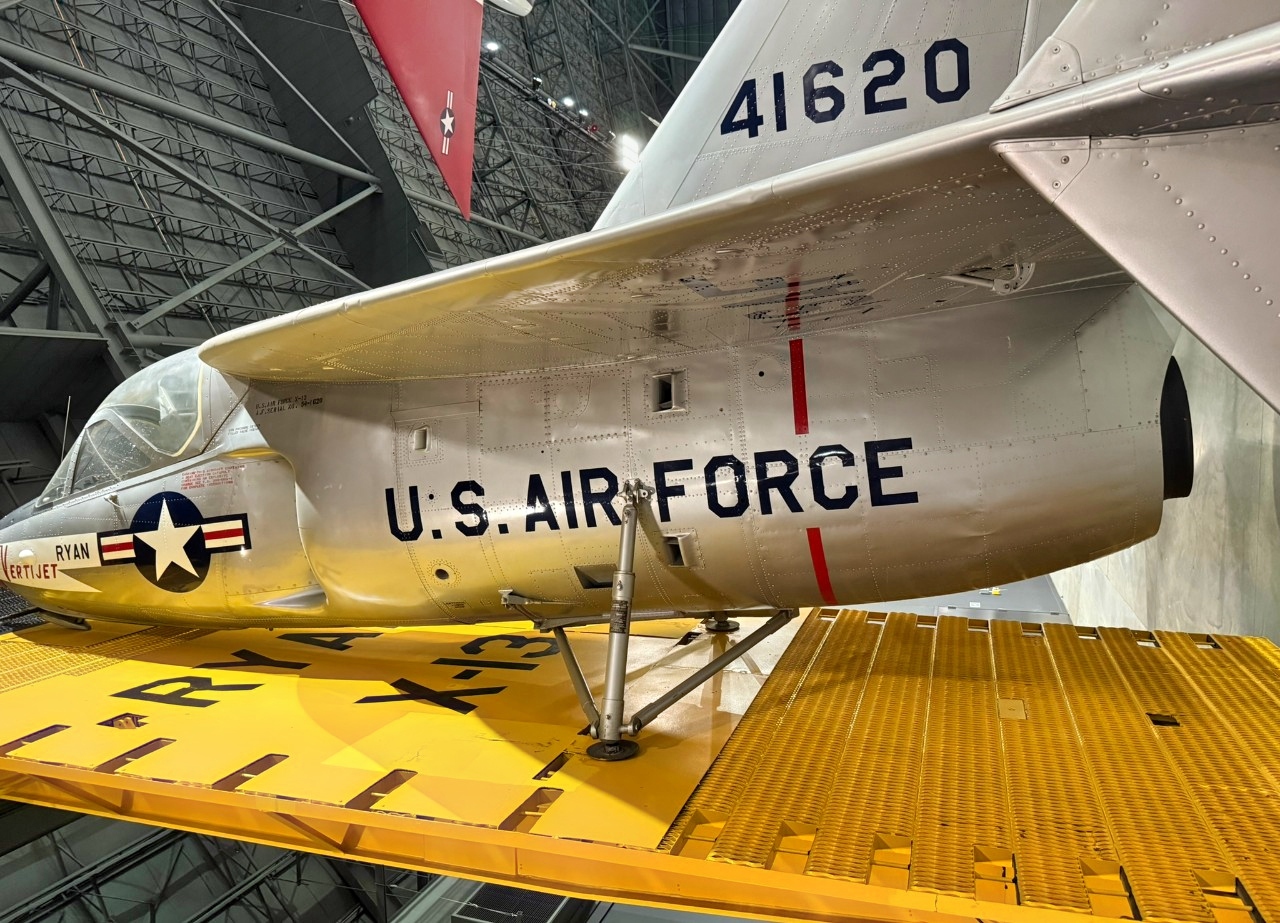
Ryan X-13 NSJ Photo
Payload, Fuel, And Mission Fit. The very features that made the X-13 agile—small wing, light structure, single engine—also capped its useful load and fuel fraction. A dispersed VTOL fighter that can’t carry useful weapons or stay airborne long enough to fight is an elegant way to lose wars. The Air Force’s own analysis showed that once you hauled real avionics and weapons and planned for vertical recovery fuel reserves, range and punch looked meager compared to conventional jets.
Better VTOL Paths Emerged. The tail-sitter is just one branch on the VTOL tree. Other concepts—lift jets, vectored thrust, tilt-wings—promised to land like an airplane (or close to it), giving pilots better sightlines and handling in the last ten feet. As those alternatives matured, the case for training thousands of pilots to land standing on the tail evaporated. The Navy’s earlier tail-sitter experiments reached the same conclusion, and their lessons carried weight.
In short, the X-13 proved a how, but not a compelling why for squadron service.
The Pentagon Demo And The End Of The Line
The pivotal year was 1957. The X-13’s public success made headlines, but inside the Air Force the question had already shifted from “Can we?” to “Should we?” Planners had better data on runway repair, dispersal tactics, and nuclear hardening of existing bases; they had improving air refueling to extend conventional jets’ reach; and they could see that tail-sitting would create a separate, bespoke training and maintenance pipeline.
By 1958, with the concept validated and no clear operational path, the service shut the program down after building two aircraft. The prototypes became museum pieces, and the trailer—arguably as important as the airplane—followed them into history.
What The X-13 Gave To Everyone Who Came After
Calling the Vertijet a failure misses what it taught. Three enduring gifts stand out:
Reaction Controls For Jets. The X-13’s “puffers” were the seed for reaction-control systems on many aircraft and spacecraft that need authority when airspeed is near zero—ideas that find their way into spaceplanes, high-alpha research jets, and, in spirit, the modern post-stall control tricks on advanced fighters.
Pilot-Vehicle Interface At The Edge. Ryan’s team wrestled with what the pilot needs to see and feel while hovering and transitioning. The tilting seat, the canopy sightlines, the symbology, and the hand-eye choreography at low speed all informed later VTOL cockpits—even on aircraft that didn’t tail-sit.
A Systems View Of Basing. The Vertijet forced engineers to treat the ground kit as part of the aircraft: the trailer, winch, line, and procedures were the other half of the airplane. That mindset—designing the ecosystem, not just the airframe—shows up in every successful expeditionary platform since.
Why The Tail-Sitter Keeps Haunting Museums, Not Flight Lines
A tail-sitter is mesmerizing to watch, and the logic seems irresistible during briefings about runway vulnerability. But operations are built on average days as well as the perfect ones. In average weather, with average fatigue, with average winds and visibility, a tail-sitter asks too much of too many things: pilot, engine, ground crew, and basing site. Meanwhile, technologies that preserve the last ten seconds of a landing—gear on concrete, wing generating lift, pilot looking over the nose—are simply easier to teach and safer to repeat.
That doesn’t mean the ambition was wrong. It means the solution space moved. The world kept the X-13’s control ideas and discarded its posture.
Legacy: Proof That Daring Is A Service To Prudence
The Ryan X-13 Vertijet distilled the 1950s: daring, elegant, and unafraid to try something that looked impossible. It took an abstract basing problem—“what if we lose the runway?”—and answered with a flying, recoverable machine that did exactly what it said on the tin. Then it stepped aside as better, more operationally forgiving VTOL paths emerged.
Stand near the Vertijet in Dayton as I did, and the airplane still sells the dream. A small jet, bright with promise, that outwitted gravity without a single square foot of concrete. The Air Force didn’t buy the dream. But it banked the knowledge—and that, in the long run, is how you get to aircraft that can hover when they must and fly like fighters when they can.
About the Author: Harry J. Kazianis
Harry J. Kazianis (@Grecianformula) is Editor-In-Chief and President of National Security Journal. He was the former Senior Director of National Security Affairs at the Center for the National Interest (CFTNI), a foreign policy think tank founded by Richard Nixon based in Washington, DC. Harry has over a decade of experience in think tanks and national security publishing. His ideas have been published in the NY Times, The Washington Post, The Wall Street Journal, CNN, and many other outlets worldwide. He has held positions at CSIS, the Heritage Foundation, the University of Nottingham, and several other institutions related to national security research and studies. He is the former Executive Editor of the National Interest and the Diplomat. He holds a Master’s degree focusing on international affairs from Harvard University.
More Military
MBT-70: The Super Tank Built to Fight WWIII Against Russia
The M48 Tank Has a Message for the U.S. Army
Su-75 Checkmate: Russia’s Big Stealth Fighter Flop


